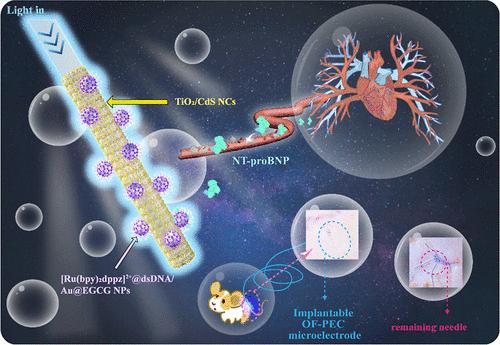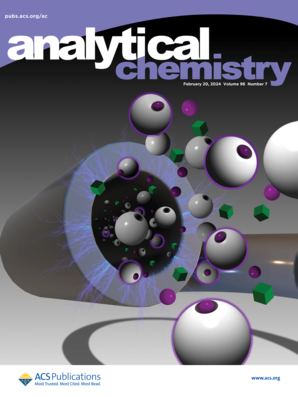Nanoencapsulated Optical Fiber-Based PEC Microelectrode: Highly Sensitive and Specific Detection of NT-proBNP and Its Implantable Performance
IF 6.7
1区 化学
Q1 CHEMISTRY, ANALYTICAL
引用次数: 0
Abstract
Microelectrodes offer exceptional sensitivity, rapid response, and versatility, making them ideal for real-time detection and monitoring applications. Photoelectrochemical (PEC) sensors have shown great value in many fields due to their high sensitivity, fast response, and ease of operation. Nevertheless, conventional PEC sensing relies on cumbersome external light sources and bulky electrodes, hindering its miniaturization and implantation, thereby limiting its application in real-time disease monitoring. To overcome these limitations, we developed a nanoencapsulated optical fiber (OF)-based PEC microelectrode. The microelectrode features TiO2/CdS nanocrystals and bis (2,2′-bipyridine) (10-methylphenanthroline [3,2-a:2′3′-c] pyridine ruthenium(II) dichloride ([Ru(bpy)2dppz]2+) @dsDNA/Au@epigallocatechin gallate nanoparticle (EGCG NP) layers. And its application for the detection of N-terminal pro-brain natriuretic peptide (NT-proBNP) as a biomarker of cardiovascular diseases was explored. An extensive linear range of 1–5000 pg mL–1 combined with a low detection limit of 0.36 pg mL–1 was achieved. This range covers not only the recommended threshold for excluding cardiovascular diseases in the clinical diagnosis of individuals across all age groups but also the prognostic target value. The sensor exhibited excellent selectivity and stability and notable labeling recovery capability in serum tests. Critically, the sensor successfully discriminated the alterations in NT-proBNP secretion levels within human smooth muscle cells, comparing pre- and poststimulation by platelet-derived growth factor-BB. Even more significantly, the skin puncture experiment conducted in mice demonstrated the remarkable implantability and biological compatibility of the OF-PEC microelectrode. This addresses critical challenges commonly faced by microelectrodes when used as implanted devices, such as minimizing invasive trauma, mitigating inflammation, and preventing biofouling, thereby firmly establishing their suitability for the development of advanced implantable sensing devices. Therefore, the present OF microelectrode PEC biosensor is not only cost-effective, easy to operate, and miniaturized but also holds significant potential for enabling more precise, more minimally invasive, and continuous monitoring of biological markers without causing inflammation. This capability is crucial for early disease detection, tracking disease progression, and facilitating personalized treatment strategies, which expands the practical application of PEC sensors.

求助全文
约1分钟内获得全文
求助全文
来源期刊

Analytical Chemistry
化学-分析化学
CiteScore
12.10
自引率
12.20%
发文量
1949
审稿时长
1.4 months
期刊介绍:
Analytical Chemistry, a peer-reviewed research journal, focuses on disseminating new and original knowledge across all branches of analytical chemistry. Fundamental articles may explore general principles of chemical measurement science and need not directly address existing or potential analytical methodology. They can be entirely theoretical or report experimental results. Contributions may cover various phases of analytical operations, including sampling, bioanalysis, electrochemistry, mass spectrometry, microscale and nanoscale systems, environmental analysis, separations, spectroscopy, chemical reactions and selectivity, instrumentation, imaging, surface analysis, and data processing. Papers discussing known analytical methods should present a significant, original application of the method, a notable improvement, or results on an important analyte.
 求助内容:
求助内容: 应助结果提醒方式:
应助结果提醒方式:


